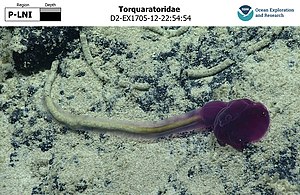Torquaratoridae
| Torquaratoridae | ||||||||||||
|---|---|---|---|---|---|---|---|---|---|---|---|---|

Torquaratoridae |
||||||||||||
| Systematics | ||||||||||||
|
||||||||||||
| Scientific name | ||||||||||||
| Torquaratoridae | ||||||||||||
| Holland , Clague , Gordon , Gebruk , Pawson & Vecchione , 2005 |
The Torquaratoridae are a family of acorn worms (Enteropneusta) found in the deep sea . The family was not scientifically described until 2005 using a specimen of the species Torquarator bullocki caught in the northern Pacific at a depth of 1901 m . Animals that are now part of the family have been known since 1965 through photos with more or less poor resolution. Because of their broad front part (prosoma), the animals were viewed as a mosaic form between the tentacle-bearing wing gills (Pterobranchia) and the tentacle-free acorn worms, received the provisional name "Lophenteropneusten" ( Gr. "Lophos" = crown, comb, crest + Enteropneusta) and it became a basal position within the gill prone species (Hemichordata) is assumed. The family was named after the type genus Torquarator , whose name is composed of "torques" ( Lat. = Collar) and "arator" (ploughman) and refers to the fact that the animals plow through the sediment with their collar area to forage.
features
The authors of the first description stated that the characteristic features of the Torquaratoridae are the broad front part (prosoma), the noticeably broadened collar (mesosoma), a large sack-shaped protuberance in the mesentery (hepatic caeca) and gill arches that are not connected by synapticel.
Osborn and colleagues changed the diagnosis of the Torquaratoridae and defined them as those acorns that lack the skeletal rod in the prosoma or are reduced to a small plate and whose adults lack the stomochord (a short support rod that extends from the foregut and protrudes into the prosoma) or is separated from the collar.
Residential tubes
In an investigation in Antarctic waters, animals belonging to the family were found in water depths between 531 and 1111 meters. Remarkably, these lived in translucent, self-secluded tubes anchored to the sea floor. Such tubes were previously unknown in acorn worms, but they are typical of the wing gill. A fossil acorn worm species found in the central Cambrian Burgess schist already showed a similar tube formation.
Genera and species
Six species are currently known, which are assigned to four genera:
-
Allapasus Holland, Kuhnz & Osborn, 2012
- Allapasus aurantiacus Holland, Kuhnz & Osborn, 2012
- Allapasus isidis Priede, Osborn, Gebruk, Jones, Shale, Rogacheva & Holland, 2012
-
Tergivelum Holland, Jones, Ellena, Ruhl & Smith, 2009
- Tergivelum baldwinae Holland, Jones, Ellena, Ruhl & Smith, 2009
- Tergivelum cinnabarinum Priede, Osborn, Gebruk, Jones, Shale, Rogacheva & Holland, 2012
-
Torquarator Holland, Clague, Gordon, Gebruk, Pawson & Vecchione, 2005 ( type genus )
- Torquarator bullocki Holland, Clague, Gordon, Gebruk, Pawson & Vecchione, 2005
-
Yoda Priede, Osborn, Gebruk, Jones, Shale, Rogacheva & Holland, 2012
- Yoda purpurata Priede, Osborn, Gebruk, Jones, Shale, Rogacheva & Holland, 2012 (named after Yoda from Star Wars )
In addition, on the basis of deep-sea photos, one can distinguish at least four other genera with one or two species that could not be scientifically described up to now because no specimen copies were caught.
In a phylogenomic analysis in 2014, the Torquaratoridae were nested in the family Ptychoderidae, so they may represent a specialized line of development of these, despite the morphological apomorphies that were previously assessed as convincing. In April 2017, however, the family was still valid in the Hemichordata World Database accepted.
literature
- Nicholas D. Holland, David A. Clague, Dennis P. Gordon, Andrey Gebruk, David L. Pawson & Michael Vecchione: 'Lophenteropneust' hypothesis refuted by collection and photos of new deep-sea hemichordates. (PDF; 281 kB) Nature 434, pages 374–376, March 17, 2005, doi: 10.1038 / nature03382
- Karen J. Osborn, Linda A. Kuhnz, Imants G. Priede, Makoto Urata, Andrey V. Gebruk & Nicholas D. Holland: Diversification of acorn worms (Hemichordata, Enteropneusta) revealed in the deep sea (PDF; 1.3 MB) Proceedings of the Royal Society Series B, November 2011, doi: 10.1098 / rspb.2011.1916
Individual evidence
- ^ Lemche, H., B. Hansen, FJ Madsen, OS Tendal & T. Wolff, 1976: Hadal life as analyzed from photographs. - Vidensk. Medd. Dansk. Naturh. Forums. 139: 263-336.
- ↑ Kenneth M. Halanych, Johanna T. Cannon, Andrew R. Mahon, Billie J. Swalla, Craig R. Smith (2013): Modern Antarctic acorn worms form tubes. Nature Communications 4: 2738 doi : 10.1038 / ncomms3738
- ^ Jean-Bernard Caron, Simon Conway Morris, Christopher B. Cameron (2013): Tubicolous enteropneusts from the Cambrian period. Nature 495: 503-506. doi : 10.1038 / nature12017
- ↑ Johanna T. Cannon, Kevin M. Kocot, Damien S. Waits, David A. Weese, Billie J. Swalla, Scott R. Santos, Kenneth M. Halanych (2014): Phylogenomic Resolution of the Hemichordate and Echinoderm Clade. Current Biology 24: 2827-2832. doi : 10.1016 / j.cub.2014.10.016
- ↑ Konikoff, C. (2011). Torquaratoridae Holland, Clague, Gordon, Gebruk, Pawson & Vecchione, 2005. In: Shenkar, N., Swalla, BJ, van der Land, J. (2017). Hemichordata World Database. Retrieved April 14, 2017.
Web links
- Konikoff, C. (2013). Torquaratoridae . In: Shenkar, N; Swalla, BJ; van der Land, J. (2013) Hemichordata World Database, World Register of Marine Species.